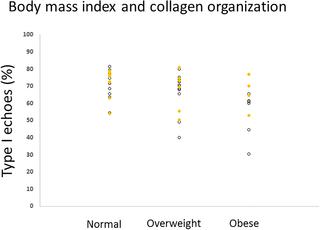PLOS ONE ( IF 3.7 ) Pub Date : 2018-06-21 , DOI: 10.1371/journal.pone.0199645 Agnetha de Sá , David A. Hart , Karim Khan , Alexander Scott

|
Introduction
Statins are widely used to inhibit cholesterol production in the liver among people with hypercholesterolemia. A recent epidemiological study in the UK has shown that statin use (unlike elevated BMI) is not associated with an increased risk of Achilles tendon rupture. However, because of laboratory reports suggesting a negative influence of statins on tenocyte metabolism, we decided to directly compare the Achilles tendon structure (cross-sectional area and longitudinal collagen organization) in regular statin users compared to non-users.
Methods
We conducted ultrasound tissue characterization (UTC) of the Achilles tendon in statin users and a comparison group of similar age and gender. Statin users and control participants were recruited from May 10 2015 to February 17 2017 through a cardiovascular health centre and from the general community. Cross-sectional area of the Achilles tendon and longitudinal collagen organization (% type I echoes) were assessed using quantitative ultrasound tissue characterization by a blinded observer at a predetermined location (2 cm proximal to the calcaneus).
Results
Sixty-six individuals who were either taking statins for at least one year (ST, n = 33) or a comparison group who had never taken statins (CG, n = 33) were included in the study. The Achilles tendon cross-sectional area (ST 59.7 (13) mm2, CG 59.9 (8.5) mm2) and proportion of echo-type I patterns [ST 70 (10)%, CG 74 (13)%] were equivalent in the two groups. In contrast, there was a negative correlation between BMI (rs = -0.25, p = 0.042) and type I echo values. Obese individuals demonstrated a significantly lower percentage of type I echoes (62 (11)%) than individuals of normal body mass index (73 (10)% p<0.05).
Conclusion
These findings demonstrate that there is no evidence of a negative statin influence on Achilles tendon structure. Given earlier reports that the risk of Achilles injury is equivalent in statin users and non-users, weightbearing exercise may be prescribed without placing the Achilles tendon at a higher risk of injury than among the general population. The results of this study are consistent with the known negative effects of elevated BMI on tendon structure, suggesting that an assessment of the Achilles tendons prior to prescribing weightbearing exercise may be prudent in obese individuals.
中文翻译:

跟腱结构与体重指数呈负相关,但不受他汀类药物使用的影响:利用超声组织表征进行的横断面研究
介绍
他汀类药物被广泛用于抑制高胆固醇血症患者肝脏中胆固醇的产生。英国最近的一项流行病学研究表明,使用他汀类药物(不同于BMI升高)与跟腱断裂的风险增加无关。但是,由于实验室报告表明他汀类药物对肌腱细胞代谢具有负面影响,因此我们决定直接比较普通他汀类药物使用者与非使用者之间的跟腱结构(横截面积和纵向胶原组织)。
方法
我们对他汀类药物使用者和年龄和性别相近的对照组进行了跟腱的超声组织表征(UTC)。从2015年5月10日至2017年2月17日,通过心血管健康中心和一般社区招募了Statin使用者和对照组参与者。使用盲目观察者在预定位置(跟骨近端2 cm)使用定量超声组织特征评估跟腱的横截面积和纵向胶原组织(I型回声百分比)。
结果
该研究共纳入了66名服用他汀类药物至少一年(ST,n = 33)或从未服用他汀类药物(CG,n = 33)的对照组。跟腱横截面面积(ST 59.7(13)mm 2,CG 59.9(8.5)mm 2)和回波I型图形的比例[ST 70(10)%,CG 74(13)%]与两组。相反,BMI(r s = -0.25,p = 0.042)与I型回波值之间呈负相关。肥胖个体的I型回声百分比(62(11)%)显着低于正常体重指数的个体(73(10)%,p <0.05)。
结论
这些发现表明,没有证据表明他汀类药物对跟腱结构有负面影响。鉴于较早的报告显示,他汀类药物使用者和非使用者与阿奇里斯氏受伤的风险相当,因此可以处方负重锻炼,而不使跟腱比普通人群承受更高的伤害风险。这项研究的结果与已知的BMI升高对肌腱结构的负面影响相一致,这表明在进行负重运动之前对跟腱进行评估对于肥胖者可能是谨慎的。



























 京公网安备 11010802027423号
京公网安备 11010802027423号